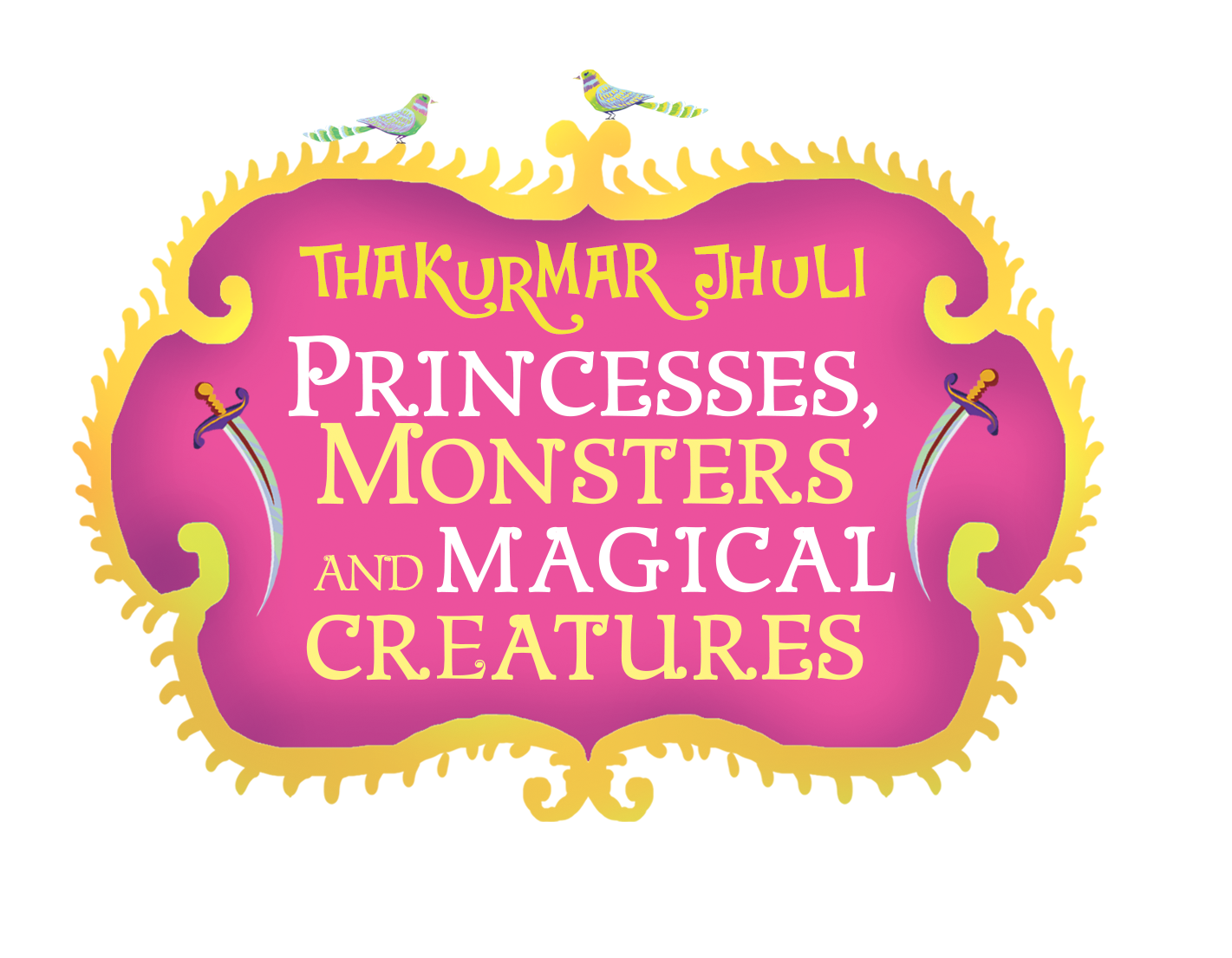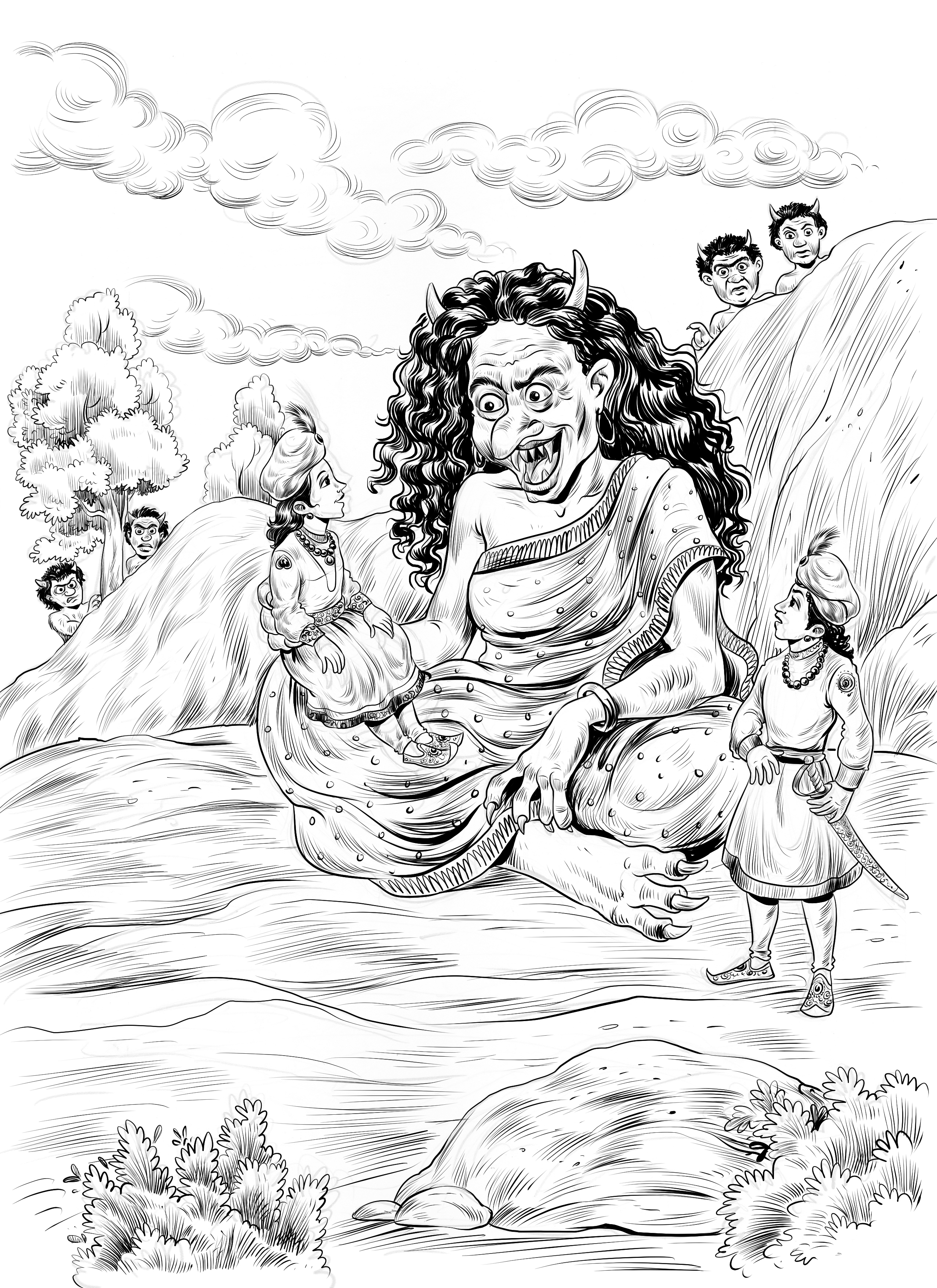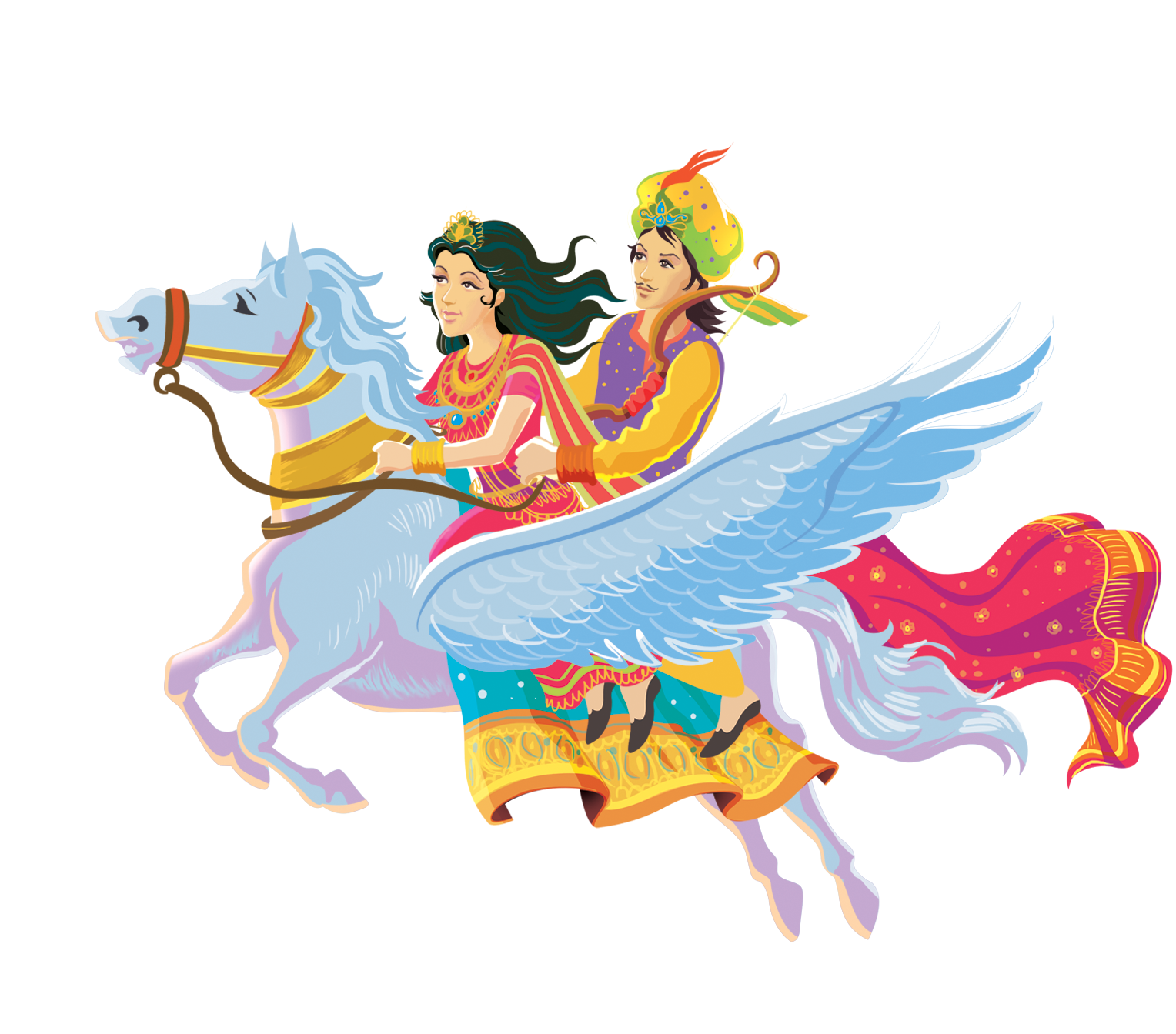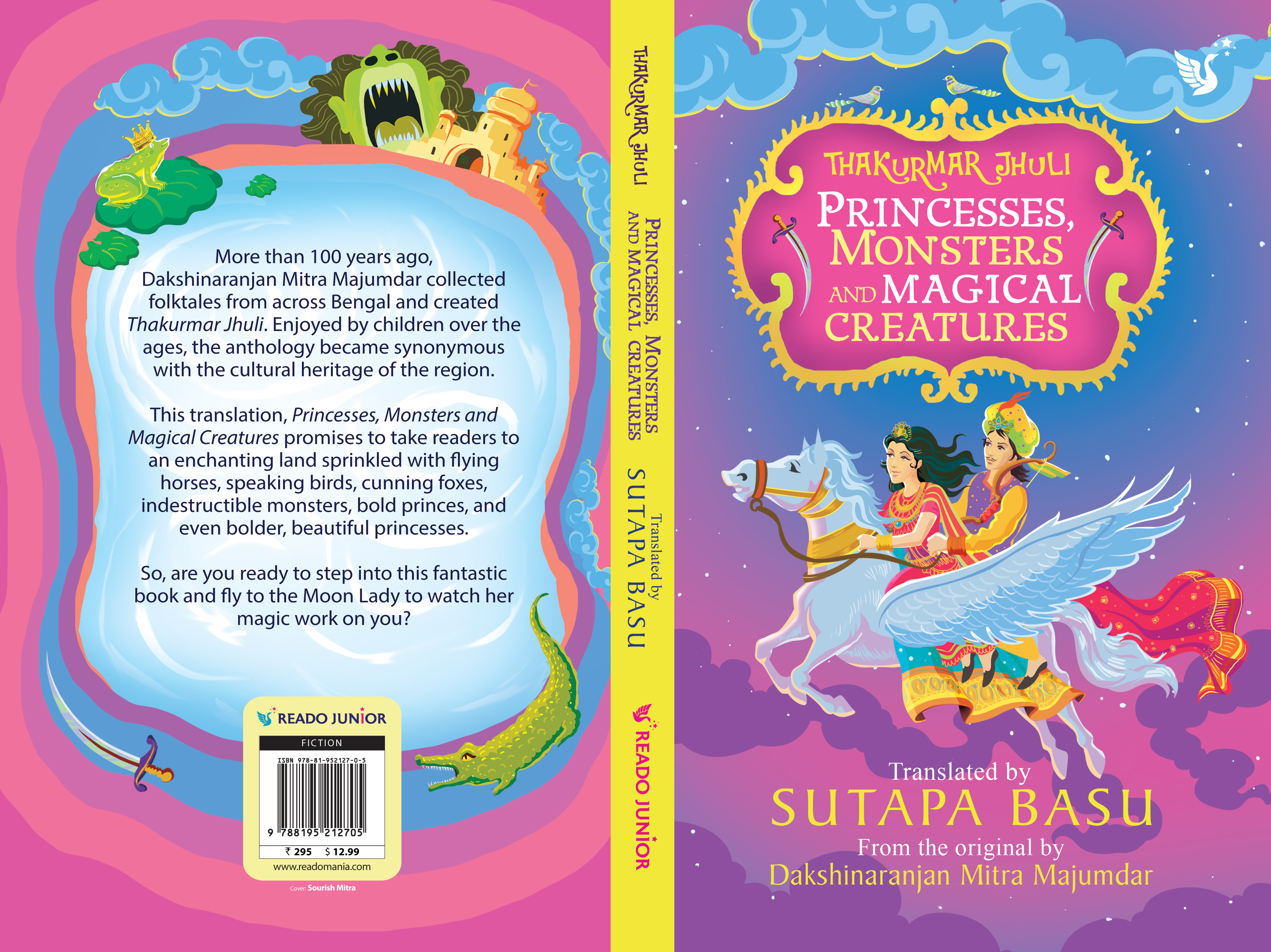For ages, I have been dreaming of translating Thukurmar Jhuli, the Bengali collection of stories written by Dakshinaranjan Mitra Majumdar, into English. My aspiration was to break the language barrier and take my favourite childhood stories to a wider audience who could enjoy them in English.
When Readomania agreed to turn my dream into reality, I was excited. Enthusiastically, I garnered the help of a Bangla-English dictionary and my elusive husband’s knowledge of Bengali for the project. I intended to adhere completely to the original, use imagery to the hilt for I was convinced the original Thakurmar Jhuli was so enchanting because of the beautiful pictures it formed in the readers’ imagination. To attract readers habituated to western notions of fairy tales, I called my book, Princesses, Monsters, and Magical Creatures.

Opening my laptop with the hard-bound blue and gold Bengali Thakurmar Jhuli at hand, I dived in. A few pages into the project and the challenges hit me hard.
Challenge#1Linguistic equivalent
Bengali and English are both extremely evolved and expressive languages. However, they have specific nuances as well as extensive differences in language, jargon, style, vocabulary, idioms, voice, and vernacular verbalization. How could I make the translation express the same ideas as in the original while not losing any of their aura? Given that my aim was to translate and not transliterate, I had to be very careful to adhere to the impressions, emotions, and ambience of the original work and find their equivalent expressions as closely as possible that the linguistic complexities of the English language would allow. As you can imagine, it turned out to be a very painstaking task. Sometimes, I spent hours looking for an exact word to reflect a specific expression, then had to give up and look for a compromise. Nevertheless, with perseverance, I found my way and managed to create this 240-page epistle.
Challenge#2 Matching linguistic ability of young readers
I was constantly alert to the fact that the vocabulary of the translation had to cater to the linguistic ability of children generally aged between 7 and 12 years. For instance, to express a river’s gentle movement between hills, I felt ‘meandering through the hills’ as too difficult and preferred writing ‘twisting through the hills’ as more appropriate. I had to constantly search for synonyms and concepts that were simpler and yet fitted the meaning or situation. I had to ensure that vocabulary, ideas, and all conversations had to consciously match the intellectual grasp of the readers’ age.
Challenge#3 Creating melody
Bengali and possibly many Indian languages are very melodic due to their auditory inflections. Onomatopoeia is commonly used as verbs and adjectives to enhance nouns in Bengali. However, the English language did not have such a vast range of reverberating words. At the same time, children enjoy saying, reading, and chanting sound words because of their natural inclination to rhythm and music. How should I cope with this aspect? I overcame this dearth of onomatopoeia in English by creating expressions that by themselves would be meaningless but when attached to specific nouns would create pictures for readers to imagine, such as ‘Angrily, the rakhoshi queen gnashed her teeth…grrunch, grrunch, grrunch! Furiously, her nails clawed her skin…skratch, skratch, skratch!’

Challenge#4 Sustaining original expressions
However, certain Bengali onomatopoeic expressions are so inherent to the story that replacing them would destroy its bewitching appeal. But retaining them in totality would make them incomprehensible hurdles for a reader with no knowledge of Bengali. So how much of the expressions should I retain without frustrating the average reader? I decided to sustain the Bengali expressions commonly heard and extend them with explanatory text in English. Here is an example:
‘Haou! Maou! Khau!
Will eat up our foe.’
Challenge #5 Retaining irreplaceables
There are a few words that I have retained in their original form for there is no equivalent for them in the English language with the same meaning. Some of these are ‘Rakhosh’, ‘Khokosh’, or ‘pakshiraj’ and more that are irreplaceable. I have described them extensively in the stories so that the readers can easily picture them in their minds.

Challenge#6 Navigating old ideas
The original stories were collected by Dakshinaranjan Mitra nearly a hundred years ago from oral renditions. We can safely assume that the stories were much older than 100 years. We know that customs, traditions, and societal norms were very different from what they are now. The original Thakurmar Jhuli reflects much of the environment in which it was first conceived. Would those conventions seem incomprehensible to young readers today? I did not think so. I believe that it would make children aware of how people lived or their attitudes more than 100 years ago. They will become conscious of how much society, traditions, the beliefs of people have changed since then. Only when they know about the misguided customs that people followed in the past will they realise how much more enlightened people are today. For them, it would be a study in comparisons and the realisation that they live in a much better world today.
Challenge#7 Diluting patriarchy
No doubt, the stories also reflect misogynist traditions of the past, such as kings with many wives or attitudes of male domination. While the young readers will themselves be able to discern how these customs raised the many problems and difficulties around which the stories revolve, as a writer I have tried to tweak the flow of the stories so that they profile the remorse of the wrongdoer, efforts made to make up for mistakes commited, justice doled out to the wicked and rewards to the virtuous. As concerns the patriarchal attitudes of those times, I have diluted them by stressing how much women, girls, and princesses influenced the events and the male characters of the stories through their cleverness, bold ideas, and brave deeds. Many stories portray women as heroines. While I have a strong opinion that storytelling is solely for the entertainment and enjoyment of young readers nevertheless, I have subtly woven in the right attitudes and honest, honourable behaviour in the conversations of the tales.
Challenge#8 Profiling heritage
Since the original Thakurmar Jhuli has done a yeoman’s task in capturing for perpetuity the oral tradition of storytelling, I intended my translation to carry on the legacy. With this translation, a larger audience will become conscious of the history and cultural heritage of the region. Purposefully, I have set each story in a different geographical location for Bengal is renowned for its topographical variety. So, a discerning reader will be able to identify stories set in the fertile plains of River Ganga, the green, hilly terrains of North Bengal, and even the Sunderbans.
Also, the descriptions of even queens bathing in rivers and streams meant there was no running water in palaces or rooms lit with smoking lamps meant no electrical lighting; amenities that children take for granted today. Some glimpses of the political environment surface where kings were concerned about the welfare of their subjects who gave back love and loyalty in return to their rulers.
Folk art such as alpona floor patterns embellish Bengali homes on auspicious occasions even today. A passive attempt to draw the reader's attention to this art form has been made through the book’s semi-realistic illustrations in the alpona style and mentions of it in the stories. Another very popular and often-heard auspicious sound in Bengali homes is the conch shell being blown. For a long time, I grappled with finding a word to express this particular sound. Using the word, ‘ululating’ seemed above the readers’ comprehension. I actually blew into a few conch shells and realised that the sound was like an elongated ‘Om’. So, in my stories, the blowing of conches sounds like, ‘Ooohmmm! Ooohmmm!’
These are some of the challenges I faced and many of the insights I gained during the wonderful task of translating this beloved children’s fiction. Like I mentioned, this English version of Thakurmar Jhuli, Princesses, Monsters, and Magical Creatures is my dream come true. This book goes out to all my readers, young and old, with great expectations. Like the winged horse, let Princesses, Monsters, and Magical Creatures fly you to the enchanted realms of my childhood, and somewhere along the way, I am sure, it will change the way that you view the world.

MRP: 295
Available on AMAZON and READOMANIA


Comments